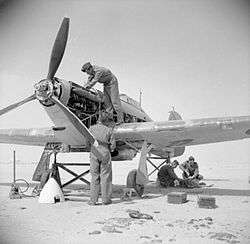No. 237 Squadron RAF
No. 237 Squadron was a Royal Air Force aircraft squadron. During the Second World War the unit was formed from No. 1 Squadron Southern Rhodesian Air Force for operations in North Africa.
| No. 237 Squadron RAF | |
|---|---|
 Mechanics fixing a Hurricane II of No. 237 Squadron in Iran, 1942 | |
| Active | 20 August 1918 – 14 May 1919 22 April 1940 – 1 January 1946 |
| Country | |
| Allegiance | |
| Branch | |
| Nickname(s) | "Rhodesia" |
| Motto(s) | Primum agmen in Cælo (Latin: The vanguard is in the sky)[1] |
| Insignia | |
| Squadron Badge | A lion passant guardant charged on the shoulder with an eagle's claw and holding in the front paw an elephant's tusk[2] |
History
No. 237 Squadron was formed at RAF Cattewater in August 1918 from Nos 420, 421, 422 and 423 flights of the Royal Naval Air Service. The squadron operated the Short 184 on coastal and anti-submarine patrols in the English Channel until it was disbanded at the end of the First World War on 14 May 1919.
By 3 September 1939 the Southern Rhodesia Air Section under Squadron Leader M. Maxwell had arrived at Nairobi in the Kenya Colony. It was then renamed as No. 1 Squadron S. Rhodesian Air Force. 237 Squadron was re-formed as No. 237 (Rhodesia) Squadron on 22 April 1940 when No. 1 Squadron Southern Rhodesia Air Force was taken into Royal Air Force control.[3] It operated a number of Hawker biplanes and was based on the Abyssinian border as an active unit of the East African Campaign, initially to defend British East Africa against the anticipated movement of Italian troops down from their bases to the North. In the Autumn of 1940 the squadron moved into Sudan for operations in Eritrea, and Westland Lysanders and Gloster Gladiators were added to its strength. In May 1941 the squadron moved into Egypt and was re-equipped with the Hawker Hurricane, being tasked with tactical reconnaissance duties in the Western Desert. In May 1942 the squadron was deployed to Iraq, as a defence against any German invasion, and then to Libya in an air defence role.
The squadron was re-equipped with the Supermarine Spitfire (Mark VCs first, then Mark IXs) and was moved to Corsica to fly operations over Southern France and Northern Italy. It eventually moved to Italy, where it operated until it was re-numbered as 93 Squadron before being disbanded on 1 January 1946.
Notable members
Ian Smith, who was later Prime Minister of Rhodesia, was assigned to the squadron during his service in World War II, and was shot down over Italy.[4]
Aircraft operated
| Dates | Aircraft | Variant | Notes |
|---|---|---|---|
| 1918–1919 | Short 184 | From the RNAS | |
| 1940 | Hawker Audax | From the SRAF | |
| 1940–1941 | Hawker Hardy | From the SRAF | |
| 1940 | Hawker Hart | ||
| 1940–1941 | Westland Lysander | I and II | |
| 1941 | Gloster Gladiator | II | |
| 1941–1942 | Hawker Hurricane | I | |
| 1943 | Hawker Hurricane | IIC | |
| 1943–1944 | Supermarine Spitfire | VB and VC | |
| 1944–1945 | Supermarine Spitfire | IX |
See also
References
Notes
- "237 Sqn | RAF Heraldry Trust". rafht.co.uk. Retrieved 2 September 2019.
- Halley 1988, p. 304.
- http://niehorster.org/017_britain/39_raf/me_group_aden.html
- Berlyn 1978, pp. 56–57.
Bibliography
- Berlyn, Phillippa (April 1978). The Quiet Man: A Biography of the Hon. Ian Douglas Smith. Salisbury: M O Collins. OCLC 4282978.CS1 maint: ref=harv (link)
- Halley, James J. The Squadrons of the Royal Air Force & Commonwealth, 1918–1988. Tonbridge, Kent, UK: Air-Britain (Historians) Ltd., 1988. ISBN 0-85130-164-9.
- Jefford, C.G. RAF Squadrons, A Comprehensive Record of the Movement and Equipment of all RAF Squadrons and their Antecedents since 1912. Shrewsbury, UK: Airlife Publishing, 1998 (Second edition 2001). ISBN 978-1-84037-141-3.
- Rawlings, John D.R. Fighter Squadrons of the RAF and their Aircraft. London: Macdonald and Jane's (Publishers) Ltd., 1969 (new edition 1976, reprinted 1978). ISBN 0-354-01028-X.
- The Illustrated Encyclopedia of Aircraft (Part Work 1982–1985). Orbis Publishing.
External links
| Wikimedia Commons has media related to No. 237 Squadron RAF. |
